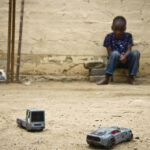While HPV vaccines will save lives, targeting schoolgirls will be hard to reach.
South Africa will become the first African country to pay for cervical cancer vaccines – one of the most expensive immunisations in the world – for schoolgirls in February next year. But experts warn that the health department will face daunting challenges, much bigger than the exorbitant cost of the vaccine.
Cervical cancer, which is caused by the sexually transmitted human papilloma virus (HPV), kills more South African women than any other cancer, according to the Medical Research Council. Every year about 6000 women, many of whom are HIV positive, are diagnosed with HPV, and at least half die.
According to Shabir Madhi of the National Institutes of Communicable Diseases, HPV vaccines are up to 90% effective against the two most common cancer-causing HPV strains (16 and 18) in women who have not yet contracted the virus.
Last month Health Minister Aaron Motsoaledi announced that the government will provide free HPV vaccines to nine- and 10-year-old girls in the poorest 80% of schools. However, the two HPV vaccines currently on the market in South Africa cost over 10 times more than what the government pays for a typical vaccine against childhood diseases – depending on the brand, one HPV shot could cost between R595 and R896 (see infographic). For instance Rotorix, a vaccine which protects against childhood diarrhoea, costs the government R70 per dose and two are needed.
World Health Organisation guidelines stipulate that three shots be given over a period of six months for the vaccine to be effective.
Some other African countries, including Rwanda and Kenya, provide the vaccine, but there it is funded either by pharmaceutical companies or the Gavi alliance, a public-private partnership that provides free immunisations to developing countries for an initial five years. South Africa is too wealthy to qualify for Gavi assistance.
The deputy director general in the department of health, Yogan Pillay, said the government would have to negotiate significantly lower prices than those in the private sector. The department is expected to settle on a price 15 to 20 times lower. “We will use the Gavi-negotiated price [of R45] and [the R125 a dose] rate of the Pan American Health Organisation in South America as benchmarks for our own negotiations,” said Pillay.
HIV infection and the vaccine
Madhi said it was difficult to estimate at which price the vaccine would be cost-effective for South Africa. “The major determining factor in South Africa would be how well it protects HIV-infected women,” he said.
“In most cases the vaccine will be given to HIV-uninfected girls. If these girls become HIV infected at a later stage, it is unclear whether there will be persistence of protection [against HPV] once their immune systems become compromised by HIV.”
According to Madhi, it is also not known by how much antiretroviral therapy (ART) would increase the effectiveness of the vaccine. “There are studies which show good immune response in HIV-positive women but none which evaluate the clinical efficacy of the vaccines if HIV infection is acquired after immunisation. Without this evidence it is difficult to calculate cost-effectiveness,” he said.
A challenge some consider bigger than the high cost of the vaccine is tracking down nine- and 10-year-old girls so they can be given vaccinations, as there is currently no established immunisation programme for this age group; child vaccines are given to children below the age of five.
The roll-out of the HPV vaccine will coincide with the upscaling of the integrated school health programme (ISHP), officially launched by the president in October last year, but it currently only targets children in grades R and one. “[The problem with targeting older children is that] they don’t access healthcare because they are healthy, or at least think they are. So the only way to reach them is through schools,” said Greta Dreyer from the University of Pretoria’s gynaecological oncology unit. “Reaching children below age five, whose parents take them for standard vaccines, is much simpler, because there is a process in place.”

According to Dreyer, for the HPV vaccine to be effective, it needs to reach at least 70% of all nine- and 10-year-old girls in the country. “If it covers 20%, it will have no effect on the overall prevalence of the disease.”
South Africa’s coverage levels of childhood vaccines have been low compared with those of other African countries with fewer resources. For instance, in the case of the polio vaccine, the country has managed to cover only 73% of children below the age of five, even with an established programme backing it, compared with Kenya’s 88% and Rwanda’s 93%, according to WHO figures.
But Pillay said the department had learned valuable lessons from the roll-out of the country’s antiretroviral therapy (ART) programme, which it also had to start without an established system. “When we started with our ART campaign, many people said we couldn’t do it and now we have the highest number of people on ART in the world,” he said. “We’ve also managed to test 20-million people for HIV in our HIV-testing campaign within the context of a fairly weak health system.”
Although the WHO recommends three HPV shots per child, the health department has opted for a two-dose regimen, with a third dose, or booster, to be given after five years. According to the National Advisory Group and Immunisation chairperson, Helen Rees, two doses are still effective and could result in significant short-term cost savings. “The booster will be given at age 14 [grade nine], which is advantageous because it is likely to renew protection and boost the immune system at a time when they’re about to become sexually active. It will also reduce initial costs, as only two doses will have to be bought.”
However, Rees said, this decision would also create more challenges in terms of reaching girls for HPV vaccinations, as the department would have to follow two age groups – 10-year-olds and 14-year-olds.
Pillay acknowledged that the department “may lose some girls along the way if they move schools or drop out”.
Awareness campaign
Gerrit Maritz, an education specialist from the United Nations Children’s Fund, said one of the biggest challenges that “will keep the ISHP steering committee awake at night” is creating a successful awareness campaign so that people will see the public good of the HPV vaccine.
Because it is a sexually transmitted virus, “very specific attention” has to be given to adults and pupils and sexual reproductive health. He said that might be more difficult because HPV is a relatively new and unknown vaccine.
According to Pillay, the health department plans to approach the awareness campaign as a cancer prevention rather than a sexually transmitted infection (STI) measure as parents may then be more willing to give consent.
“We don’t want unnecessary confounders which may hinder uptake in schools. Parents don’t think of their children as sexually active and may ask why their child will need a vaccine to protect against an STI.
“But cancer is a terrible thing we don’t want to happen to anyone and we can largely prevent this cancer just by getting a few shots,” he said.
___________________________________________________________________________________
Vaccine free for girls only
This week American actor Michael Douglas said in an interview with the Guardian that his throat cancer, diagnosed in 2010, was caused by the same virus responsible for 70% of all cervical cancer: the human papilloma virus (HPV). He claims to have contracted the sexually transmitted virus through oral sex.
This has brought the virus and HPV vaccine into the international spotlight but in a different context – should boys be vaccinated against HPV? In South Africa the government will provide free HPV vaccines to the poorest 80% of 9- and 10- year-old schoolgirls – but not boys – from February next year.
According to Helen Rees, who chairs the National Advisory Group on Immunisation, it just isn’t cost -effective to provide the vaccines to boys at this stage.
“Although oropharynx and anogenital cancers caused by HPV are increasingly common in men who have sex with men, it is too difficult to target this group when they are only nine years old,” she says.
As for heterosexual men, she said: “All the evidence suggests that if you get high coverage of the vaccine in girls then you diminish the amount of infection in the community as a whole, which then has a benefit for boys as well.”
___________________________________________________________________________________
What about the medical schemes?
The two vaccines that protect against cervical cancer are among the most expensive in the world.
Health Minister Aaron Motsoaledi recently announced that the department will provide this vaccine to nine- and 10-year-old girls in poor schools, starting from February 2014. The campaign will target girls before they become sexually active, because cervical cancer vaccines are not effective once the cancer-causing, sexually transmitted virus, HPV, has been contracted. Girls in the wealthiest 20% of schools will not be covered by the programme. “I am calling on all medical aid schemes in the country to pay for these vaccines to help parents in the category of learners who will not be covered when we commence this programme,” Motsoaledi said last month in his budget vote speech.
The Mail & Guardian asked three of South Africa’s biggest medical schemes for their reactions:
Bonitas
According to Bobby Ramasia the scheme’s prinicpal officer, Bonitas is not funding the vaccine, but “will be looking into this in more detail for upcoming benefit years”.
In the interim, the scheme has urged its members to make use of their cervical cancer screening benefits. “Important to note is that the HPV vaccine does not provide protection against all strains of the virus and, as a result, it is critical that women understand that their Pap smear checks should not be stopped. Bonitas funds Pap smears for cervical cancer screening from available benefits on all its options. The BonComprehensive option has a specific wellness benefit that allows Pap smears every three years for all female beneficiaries aged between 21 and 65 years old.”
Discovery Health
According to Noluthando Nema-tswerani from Discovery Health the scheme paid a total of 308 claims linked to cervical cancer in 2012. Currently, the vaccine can be accessed and paid for through a member’s savings account or day-to-day benefits. Some critics have argued that this may prohibit uptake, as savings accounts are in effect members’ own money put aside for doctor’s visits. Discovery recorded 3578 of its 1.228-million female members accessed the vaccine last year.
“Vaccines are typically regarded as a ‘public service’ or ‘public goods’ in the sense that it benefits not only individuals who are vaccinated but also society at large, and ultimately the broader healthcare system,” said Nematswerani. “We believe that the department of health should consider making vaccines available in the private sector at state tender prices. These prices are well below current private sector vaccine prices, and access to state tender prices would make vaccines significantly more affordable for medical schemes and their members. This would also have the very positive effect of reducing the burden of patients attending public sector clinics.”
Fedhealth
Marketing executive Peter Jordan said the scheme will be considering introducing the HPV vaccine for upcoming benefit years, but notes its cost is a big challenge.
“It is unlikely that private patients will be able to get the vaccine at the same price as government is able to procure it. Legislation states there can only be one single exit price so it is illegal to negotiate prices in the private sector. Patients may have to go to the state in order to get their vaccine at state rates. Cost is a critical factor and the vaccine will simply not be affordable to medical aid populations at the current prices. Fedhealth would encourage engagement with the vaccine manufacturers on this point.”
Amy Green was a health reporter at Bhekisisa from 2013 until 2016.





